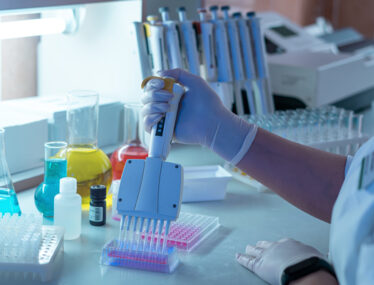Shape Up, Library Prep: Innovating for Efficient, Low Cost and Sustainable Workflows
By Simon Lesbirel

Three advances promise to overcome the final hurdle on the way to truly affordable sequencing and all the industrial applications this could enable: library preparation.
Library prep has a reputation of being cumbersome, time-consuming, and expensive. Anyone in the industry knows that traditional protocols can involve dozens of steps and occupy specialised technicians for many hours. This increases the scope for human error as well as cost. In contrast to the continually decreasing cost of sequencing, library preparation kits still often sell for hundreds of dollars per genome.
Cost is a problem in any industry, but the falling cost of next-generation sequencing (NGS) and the emergence of “third-generation” sequencing technologies, which offer rapid or even live sequence read-out, means that lengthy and costly library preparation protocols are increasingly standing in the way of applications where industrial sequencing could bring huge benefits.
Fortunately, a series of advances mean that we now have all the tools we need to reduce the number of steps and automate and reduce the environmental footprint of even the most specialised library preparation protocols.
The Power of New Automated Liquid Handling Solutions
In the library preparation arena, automation has so far mostly been achieved by means of standard, 96-well liquid handling platforms. However, while suitable for high-throughput applications, these platforms lack flexibility and often can’t address all steps in a library preparation workflow. Manual liquid handling techniques with pipettes simply cannot be reliably automated to handle tiny microlitre reagent volumes or replicate the range of delicate pipetting manoeuvres performed by technicians.
From blister packaging-based inventions to electrowetting, other technologies can be used to develop liquid handling solutions to automate library preparation protocols for users with low- to mid-throughput sequencing needs. Tecan’s MagicPrep NGS, for example, now offers library prep for DNA or RNA sequencing of up to 8 samples with as little as 10 minutes of hands-on time. It delivers low volumes with an accuracy unrivalled by manual and automated pipetting technologies. For the user, this means simple, walk-away workflows that guarantee robust and high-quality libraries.
Squarely Saving: New Molecular Tools that Cut Steps
Beyond novel liquid handling technologies, novel chemistries and bead technologies can be used to minimise the number of chemical steps and liquid transfers involved in library prep, to ultimately perform the whole workflow in a single container without liquid transfers – also known as a ‘one pot’ solution.
Tagmentation is a great example of reducing steps. It did this by fragmenting and adding sequencing adapters in a single step, while narrowing the spread of fragments lengths. Like any enzymatic process, tagmentation has the drawback of being imperfectly random and introducing biases into sequence preparation protocols. However, when it first emerged, it significantly reduced the number of steps involved in library prep compared to conventional ligation-based approaches.
Beads are another invaluable tool. When enzymes are conjugated to beads, reactions can be hosted on their surfaces, with the desired reaction products staying in solution. New England Biolabs has recently introduced Immobilized T4 DNA Ligase to enable enzyme reuse and reduce cost. If all the necessary enzymes for a library preparation protocol can be immobilised on beads, this could conceivably reduce the workflow to a series of easier-to-automate bead manipulation rather than liquid handling steps. For some applications, there may even be scope to micro-manipulate the beads themselves in order to isolate sensitive nucleic acids.
Bespoke Automation Solutions
All these tools put us in a great position to create bespoke automation solutions for even the toughest manual library preparation challenges. One example is the recently launched Long String VANTAGE developed by Hamilton and Bionano Genomics. This system supports the high-throughput isolation of ultra-high molecular weight DNA for use in optical genome mapping (OGM) or nanopore sequencing. Single cell, genomic structural applications (e.g., Hi-C or ATAC-seq), or the interactome (e.g., ChIP-seq or CLIP-Seq) could be the next challenges to be tackled with bespoke automation solutions.
Shaping up NGS for a Sustainable Future
New solutions not only reduce cost but should also improve sustainability. In library prep, this doesn’t stop at reagent volumes, reducing steps and the need for consumables. Transport and reagent refrigeration also adds to the carbon footprint associated with library preparation. Newer generations of freeze-dried reagents can be shipped and stored at room temperature, reducing the weight and volume of shipments and greenhouse gas emissions associated with refrigeration.
For the end user, temperature insensitive reagents are also easier to store and manage. In addition, the user can simply add the sample to the lyophilised reagent – another opportunity to remove the need for low volume, high viscosity liquid handling steps from the from library preparation protocols while improving environmental sustainability at the same time.
Going Full Circle: Can we Eliminate Library Preparation Entirely?
In many next-generation sequencing markets, better library preparation kits and automation solutions will reduce cost and open up new industrial applications of library prep for years to come. But we are also seeing the coming to prominence of third-generation sequencing technologies that offer rapid and live sequence readout.
We will therefore also need library preparation solutions that match the speed and efficiency of these third-generation sequencing technologies. In some instances, this may involve the elegant use of new reagent formulations, including on-flowcell library preparation. In other cases, this will require the development of the sequencing technologies themselves to accept native and relatively unclean DNA.
With these exciting advances and new sequencing instrumentation on the horizon, it begs the question: How long until cumbersome library prep protocols for users at the lab bench are a thing of the past?
Meeting the demands to improve library preparation
The challenges associated with improved library preparation protocols are complex and multi-faceted. TTP understands the value and challenge of meeting these demands. We develop innovative solutions by drawing on the diverse perspectives of our collaborative teams which include both engineers and biologists alike.
Get in touch to find out more.

